The Giant Swallowtail (Papilio cresphontes) is not the largest butterfly in North America. That distinction goes to the Eastern Tiger Swallowtail, at least to the larger females of that species. P. cresphontes, though, is still “noteworthy for its size” (Cech & Tudor). It’s also a butterfly that is rather camera shy, at least in my experience. (The only pictures of an adult Giant Swallowtail in my photo files date back to Fern Forest days, back in 2007 or 2008.)
Their larvae, however, are considerably less camera shy, and over the years I’ve noticed (and even written about) the tiny little “bird dropping” caterpillars that were showing up on the wild lime (a good Florida native plant) over in the corner of the yard. (I had thought that it was an out-of-the-way corner but wild lime is such a phenomenal grower that it’s starting to crowd out the rest of the plants over there, and with all the little thorns it carries, it does a fairly good job of getting all the space it wants!)
And their eggs, if you can find them, are even less shy of the camera, although they’re so small they’re quite difficult to get a good photo of, at least before you purchase a decent macro lens. I like the one in the shot below because, even though it was taken with a “normal” lens, the egg has a nice pearlescent sheen to it:
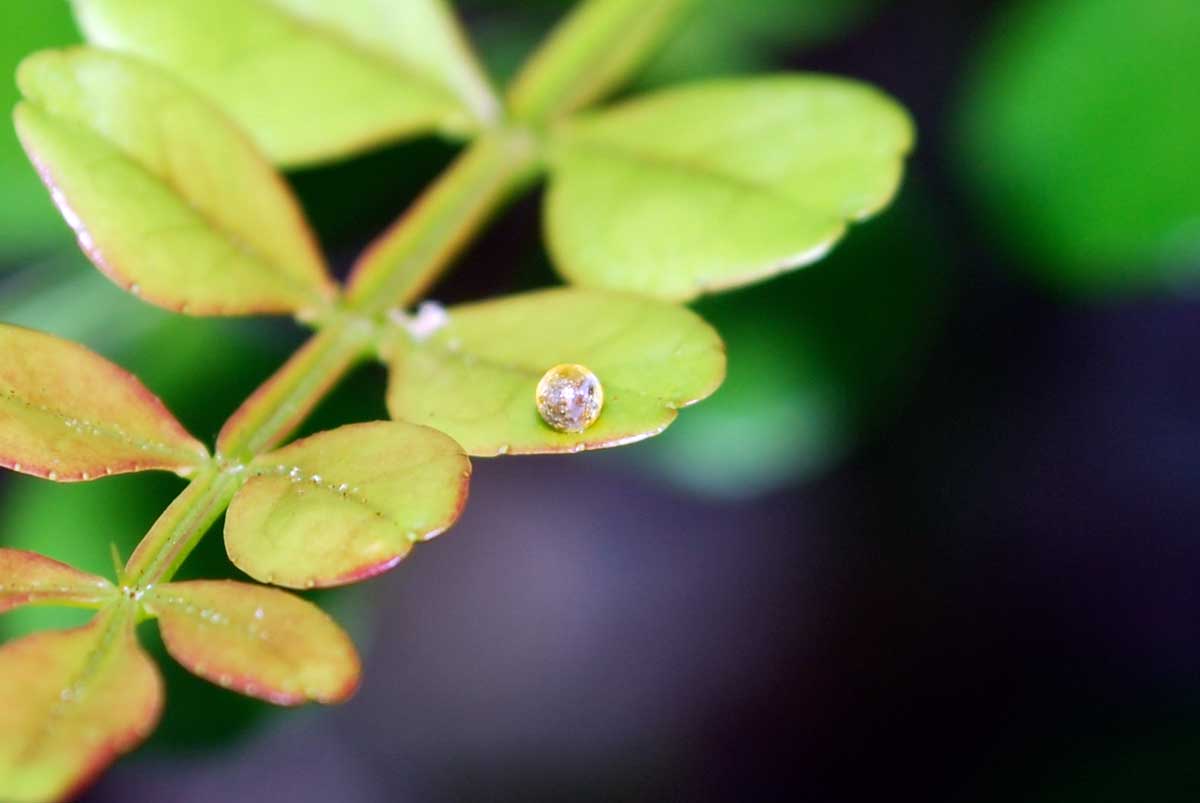
An interesting note about the host plant, Zanthoxylum fagarum: like many other plants in the citrus family (Rutaceae, or rues), it is chemically active. It produces the aromatic “essential oils” that, true to their description, carry the “essence” of the fruit with them. They are “volatiles” as well, which basically means that they are fragrant. Some of these plants in the citrus family also produce toxic chemicals, in this case furanocoumarins, that discourage herbivory. Unless, that is, the herbivore can sequester or detoxify these chemicals somehow. Famous examples of this ability to detoxify chemicals include the Monarch butterfly (which can detoxify the cardenolides in milkweeds) and the heliconians (Julia, Zebra, Gulf Fritillary) that are able to feed on passion vines by detoxifying the various substances found in those plants.
These little guys start off life just about as small as you can imagine:
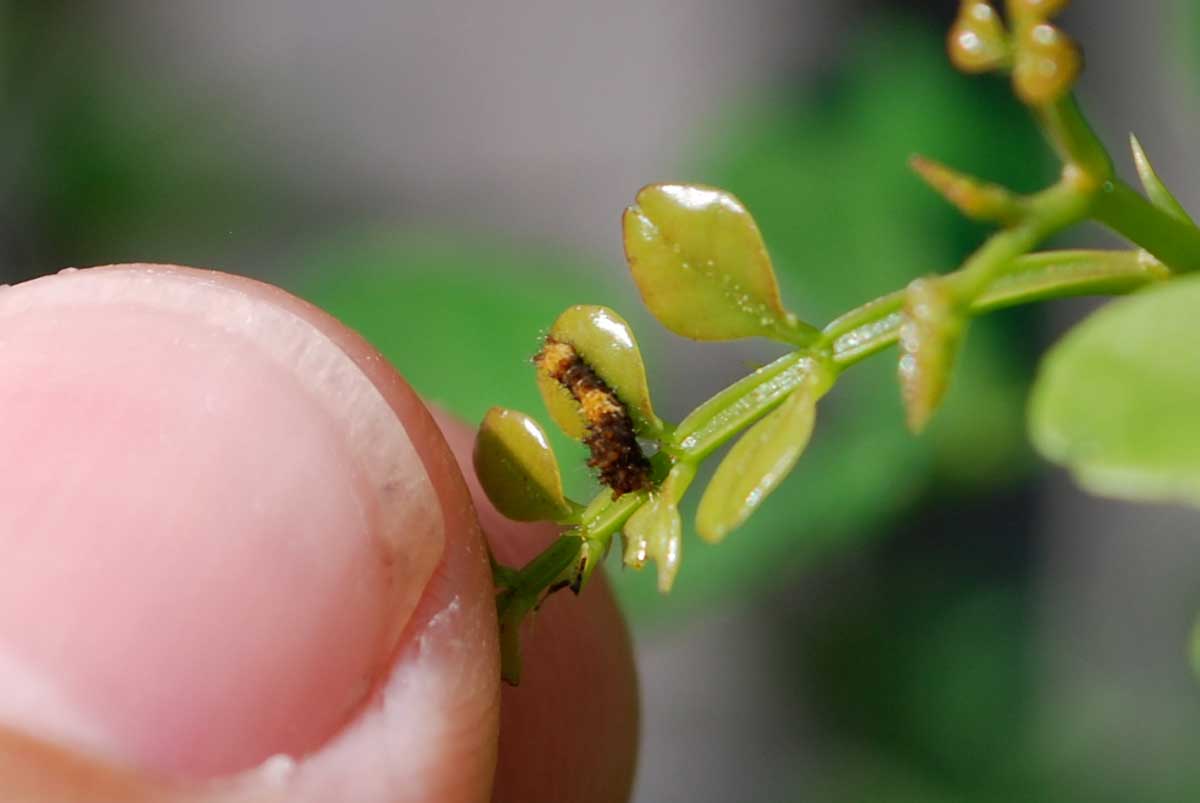
Before growing up to be one of the largest butterflies on the continent. And the “orange dog,” as the Giant Swallowtail caterpillar is named, is able to detoxify the furanocoumarins found in wild lime, and this presumably confers some survival advantages similar to that of the famous “poisonous” milkweed caterpillars like the Monarch. This chemical defense, combined with the spiny nature of the host plant and the relatively disgusting-looking camouflage it employs (not many birds, at least, are likely to try to eat something that looks like a bird dropping), allows it to pursue its life cycle relatively unmolested in my yard. I say relatively unmolested because, well, this sometimes happens:
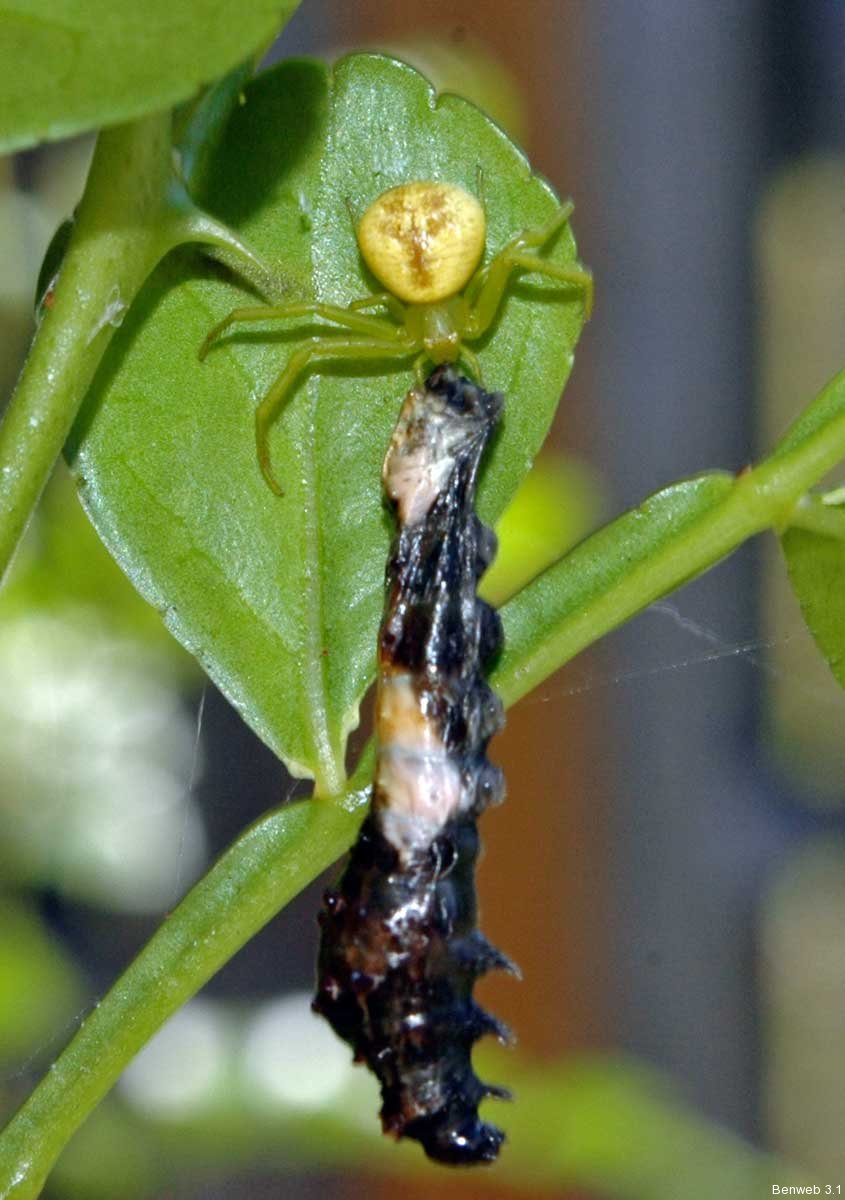
My guess is that spiders aren’t too fazed by the “bird poop” disguise, and if this thomisid (crab spider) was any more fazed by the chemical slurry inside the caterpillar, I don’t know about it.
Anyway, this week at long last, I found a cooperative adult from these (or nearby) caterpillars, and can at last bring you a picture of a Giant Swallowtail from my own back yard. Since this butterfly was in a shady area on a sunny day, I also learned a thing or two about photography. Here is the first image, taken with my 10-year-old Nikon D70, which I’ve completely forgotten how to control. I couldn’t get the flash to fire so I had to set it to “auto,” and it opened my aperture all the way up to f/3.2:
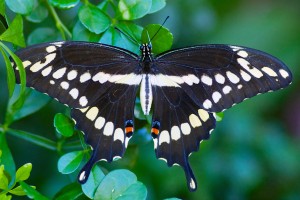
Look at how nice and bright green the background is, and how bright (some might say overexposed) the butterfly looks. It’s not a bad picture, and I’d probably have stopped right here if it hadn’t been for two things: (1) the butterfly was absolutely motionless, allowing me to approach to as close as my macro lens would let me get without batting an eyelash (not that butterflies have eyelashes, but…); and (2) the left forewing (“top” wing) was obscured by some of the foliage. Since I didn’t want to muff the next shots, and the butterfly was absolutely unmoving, I ran back inside to get my much newer D7100, which I’ve been using for the last year and a half. With this camera I was able to manually control the aperture, stopping down to f/16 to increase the depth of field. (Which, based on these images, hardly seems worth having done.) Doing so, however, made the background much, much darker, rendering these photos taken in broad daylight (admittedly, in a shady location) into “night-time” images:
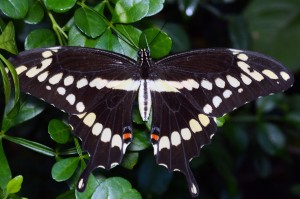
Despite the pictures being taken with digital cameras that were manufactured a decade apart (which is about a century in film years), the images are fairly comparable, except for image size (6MP for the D70, 24MP for the D7100). (I have, of course, downsampled them severely for web use.)
Throughout this whole photo shoot, the butterfly hardly moved at all. I was able to get within a foot or two of it and take photos to my heart’s content as it remained motionless in its bower.
Here’s a head shot, showing the amazing compound eyes of this large butterfly; you can see the rolled-up proboscis sticking out down below as well:
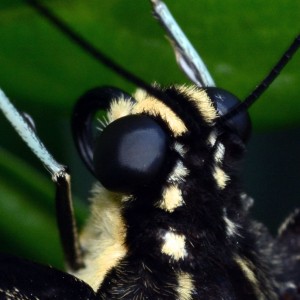
And, last but not least, on the final shot I was able to get the whole butterfly, whose left wing came out from behind the distracting leaves from the first couple of shots:
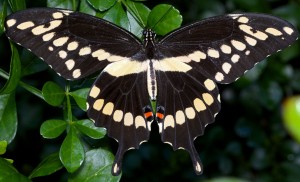
Even this shot, though, isn’t perfect. The pose isn’t quite as classic, because that darned left forewing is now slightly elevated, disrupting the symmetry of its resting position.
Shortly after I left to take pictures elsewhere in my rather small backyard, I looked back over to this corner and the butterfly was gone.
PS—according to my butterfly bible (Cech & Tudor’s Butterflies of the East Coast: An Observer’s Guide), the caterpillars of this species are called orange dogs because their “faces” (anterior ends) resemble a dog’s head. You make the call:
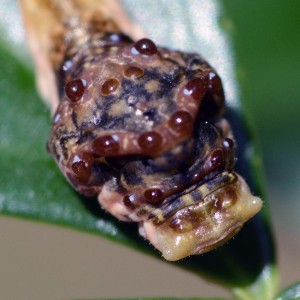

I recently retired and have discovered amazing things are going on in my backyard! The bird droppings I often found on my Meyer lemon tree turn into fascinating creatures that quickly grow as they munch on the leaves, then when they appear to be “drying out” they disappear within the next day or so. Checking on the internet I found they are baby Giant Swallowtails! The butterflies make frequent appearances in my yard, along with other varieties. I was excited that my tree is a nursery for them! The next stage is when they become a chrysalis, but I couldn’t find anything on the tree to indicate any presence of of such, although I spent a lot of time staring at my tree and searching for something that looks like the photos of any giant swallowtail chrysalis I found on the various websites I checked. After several days I noticed something that looks close, but I am not certain it is what I hope. I realize there are a lot of differences in the pix on the internet, and the thing that is attached to the bottom side of my tree branch might be just another variation. I can’t get a good photo with my phone, but to the naked eye it appears to have interesting colors, and with the angle I can get the wider end appears to be lower than the narrow end.
Can you give me any clues? I could email you the photos it that would help.
Nancy
It’s so true that there are amazing things happening in the back yard, almost no matter where you live! I have to say, I’ve never found a chrysalis either, although I’ve seen the butterflies and the caterpillars “frequently” (a few times a year). I’m afraid I wouldn’t be able to help you much. You could try posting at bugguide.net; they have a ton of talented amateur entomologists (and I’m sure many contributors are professionals) who try to help people like us out.